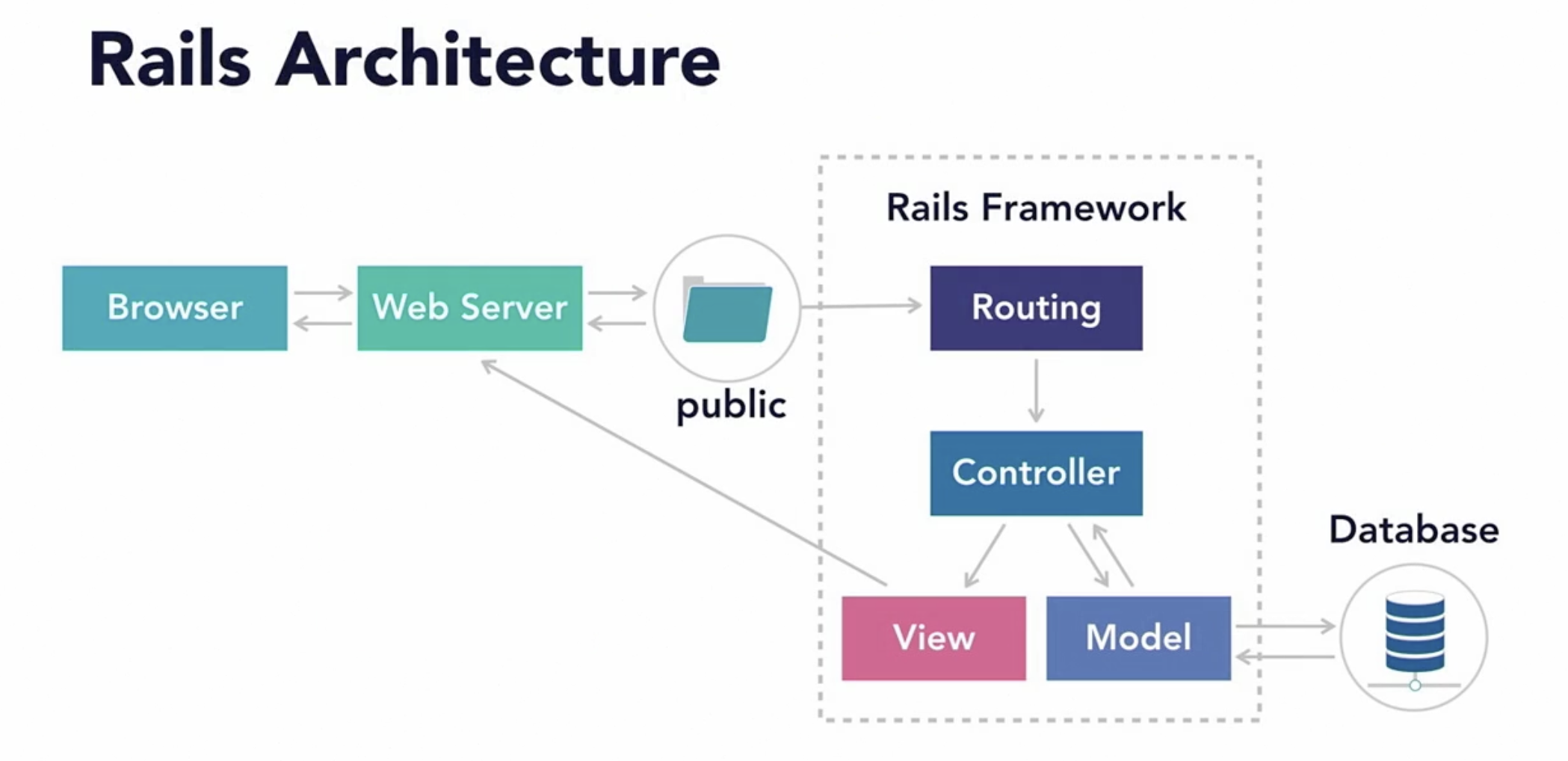Ruby on Rails (part 1)
What is Ruby on Rails
Introduction
Ruby on rail is made up of 2 parts.
- Ruby is an object oriented programming language, invented by Yukihiro Matsumoto in 1995.
- Ruby on Rail is an open-source web application framework, created by David Heinemeier Hansson in 2003.
Rails framework also has many default features built in, especially web security features.
MVC architecture
The Ruby on Rails framework uses an MVC architecture. The M stands for model, the V stands for view, and the C stands for controller. The model refers to the data objects that we use. The view is the presentation layer. It’s what the user sees and interacts with, the webpages, the HTML, the CSS, and the JavaScript. The controller processes and responds to user events, such as clicking on links and submitting forms. The controller will make decisions based on the request and then control what happens in response. It controls the interaction with our models and our views.
Getting started
Create new project
$ rails new simple_app -d mysql
The above command line creates a new project and configure it to use the mySQL database.
Configure
Look for config directory. check out application.rb. /config/initializers is where the initialization stuffs take place, right at boot. environment is where we keep configuration for each environment. database.yml is where database configurations are stored for different environment.
Access project from a browser
From command line: $rails server or $rails s to start the server.
From web, visit localhost:3000
Rails architecture

Routing
The routes file is stored in config/routes.rb.
- Simple match route
- Default route
- Root route
- Resourceful route
Simple match route
get "demo/index" #shorthand
match "demo/index", :to => "demo#index", :via => :get
we’re mapping this string to the demo controller and the index action and we’re going to do it using a get request.
Default route
get ':controller(/:action(/:id))'
match ':controller(/:action(/:id))', :via => :get
eg. GET /students/edit/52, it is going to StudentsController, edit action and 52 as its id.
Default route was the widely used in early version, but Resourceful route is getting more popular these days.
Root route
root "demo#index"
match "/", :to => "demo#index", :via => :get
if it matches nothing, it will match to the root.
Controller, Views and Dynamic Content
Render
default behavior is rendering the template matching the current controller and action.
For example, we want to have a default behavior on hello route
class DemoController < ApplicationController
layout false
def index
end
def hello
end
end
route is get demo/hello.
action is hello method inside DemoController.
view is demo/hello.html.erb.
if you want different template, use render.
render(:template => 'demo/not_default')
render('demo/not_default') # shorthand
render('not_default') # if it is under same controller
Redirect
They can also redirect or send the user to a different controller and action. Imagine this scenario, a user requests a web page that’s inside a password protected area.
When you redirect, what actually happens is that rails returns a status code to the browser which looks like this.
HTTP/1.1 302 Found
Location: http://localhost:3000/demo/hello
The location is the new URL we want the browser to try. When browsers receive this response, they automatically make a new request for this new URL.
In rails, you could do,
redirect_to(:controller => 'demo', :action => 'index')
redirect_to(controller: 'demo', action: 'index')
redirect_to(:action => 'index')
redirect_to('https://wikipedia.com')
ERB Template
<% code %> # execute without output
<%= code %> # execute with output
Instance variable
To share the instance variable to other components in MVC architecture, use @.
# DemoController
def hello
@array = [1, 2, 3, 4, 5]
end
# hello.html.erb
<% @array.times do |n| %>
<p><%= n %></p>
Link
<%= link_to(text, target) %>
Database and Migration
You can use either SQL command or Ruby migration command. If you want to test if your project is able to connect to the database as the user,
rails db:schema:dump
Generate migration
rails generate migration MigrationName
Another handy usecase is to generate model.
rails generate model ModelName
When you generate a general migration, a new file will be created in db/migration directory.
class MyMigration < ActiveRecord::Migration(6.0)
def change
end
end
change method consists of two methods, up and down. Ruby on Rails is smart enough to know that you are migrating up or down, therefore, it will reverse automatically according to your code inside change method. However, if you have different steps for up and down, you may also specify it by yourself.
class MyMigration < ActiveRecord::Migration(6.0)
def up
end
def down
end
end
Here are some common methods:
create_table, add_column,
drop_table, remove_column,
rename_table, rename_column
Next, we will see the model generation.
rails generate model User first_name:string last_name:string email:string
This will create all necessary files for User model with the parameters such as first_name, last_name and email. It also generate the test files and model files as well.
To execute them,
$rails db:migrate
This will execute all the migration scripts and update the database.
Run migration
Here are some useful rails commands.
# this will show the current status
rails db:migrate:status
# this resets to initial version
rails db:migrate VERSION=0
# this will migrate until the specified version
rails db:migrate VERSION=202408242545324
Foreign key
If you want to have foreign key, we could manually edit the file with t.belongs_to. It is a shortcut and if you are looking for longer form, t.integer :student_id, index: true or t.references :student.
class User < ActiveRecord::Migration[6.0]
def change
create_table :user do |t|
t.belongs_to :student
t.string :first_name
t.string :last_name
t.string :email
t.timestamps
end
end
end
